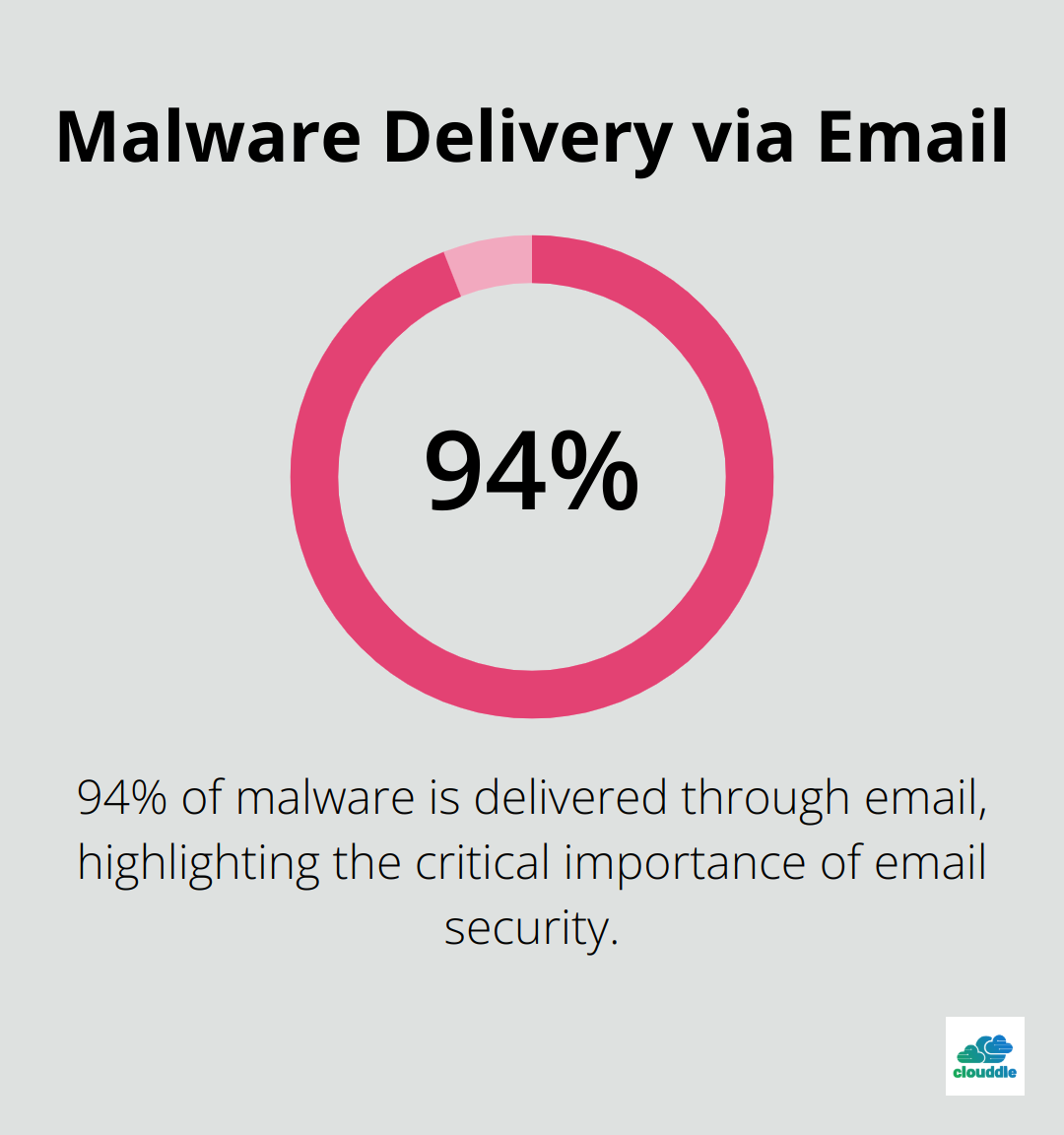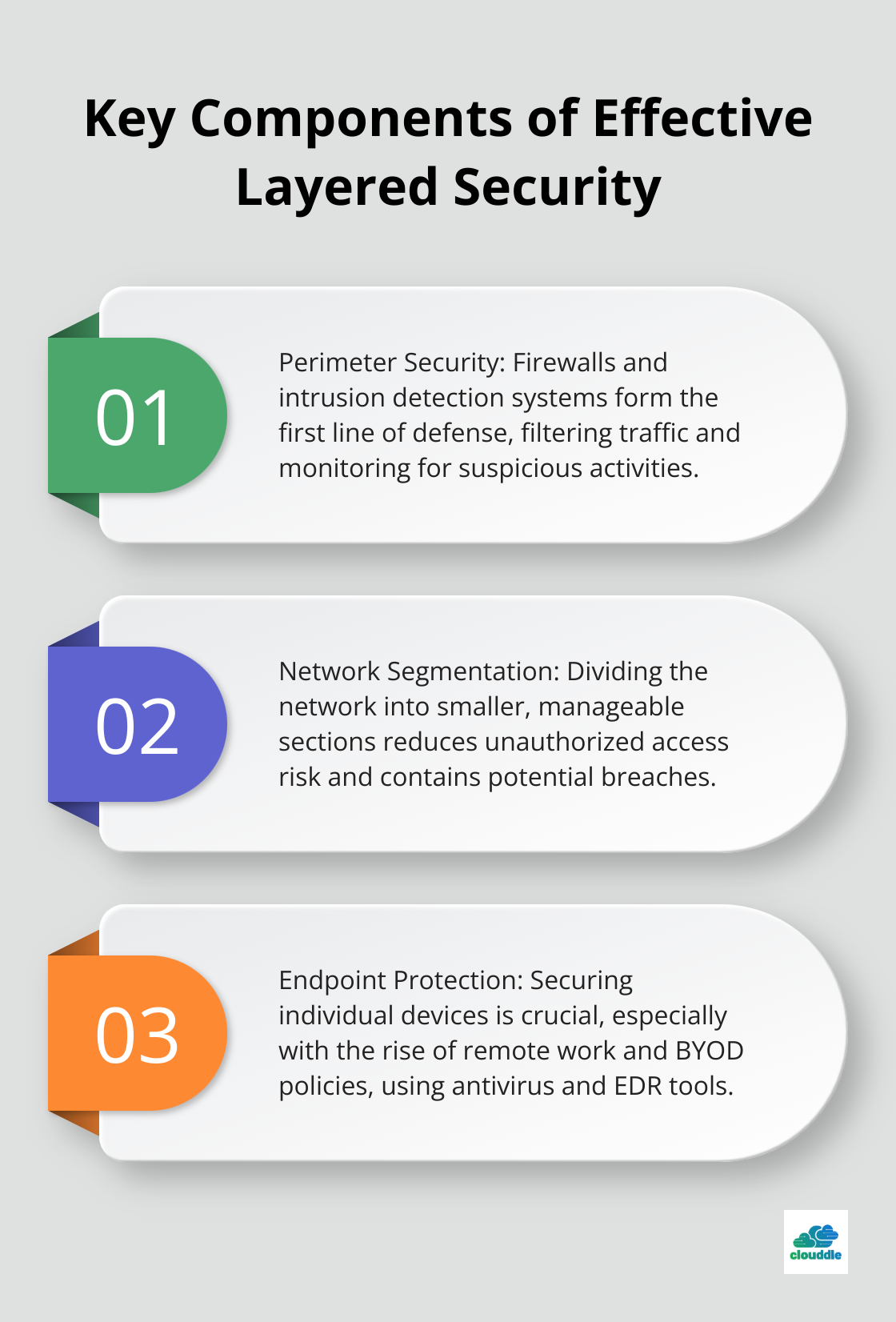In today’s digital landscape, protecting your network from cyber threats is more important than ever. At Clouddle, we’ve seen firsthand how layered network security can make the difference between a secure system and a vulnerable one.
This approach involves multiple defensive mechanisms working together to safeguard your data and infrastructure. In this post, we’ll guide you through the essential steps to implement a robust layered security strategy for your network.
What is Layered Network Security?
The Multi-Faceted Shield
Layered network security is a comprehensive approach to protect digital assets. It resembles multiple walls around a castle, each designed to stop different types of threats. This strategy deploys various security measures that work together, including firewalls, antivirus software, encryption, multi-factor authentication, and regular software updates. Each layer addresses specific vulnerabilities, creating a robust defense system.
A 2023 IBM Security report revealed that the average cost of a data breach in the U.S. reached USD 5.17 million for breached data stored in public clouds. This staggering figure underscores why a multi-layered approach is now a necessity, not an option.
Adapting to Evolving Threats
The cybersecurity landscape changes constantly. New threats emerge daily, making traditional single-layer defenses obsolete. Layered security allows organizations to adapt quickly to these evolving risks.
AT&T reports detecting an average of 180 billion security probes daily. This massive number of potential threats requires a dynamic, multi-faceted defense strategy.
Key Components for Effective Protection
An effective layered security approach includes several critical components:
- Perimeter Security: Firewalls and intrusion detection systems form the first line of defense.
- Network Segmentation: Dividing the network into smaller, manageable sections reduces unauthorized access risk.
- Endpoint Protection: Securing individual devices is crucial (especially with the rise of remote work).
- Data Encryption: Protecting sensitive information both at rest and in transit is vital.
- User Authentication: Strong password policies and multi-factor authentication significantly enhance security.
The Power of Integration
The strength of layered security lies not in the number of layers, but in how well they integrate. Each component should complement the others, creating a seamless defense system. This integration allows for more efficient threat detection and response, as different layers can share information and work together to identify and mitigate potential risks.
Continuous Improvement
Implementing layered security is not a one-time task. It requires ongoing assessment and improvement. Regular security audits, penetration testing, and employee training are essential to maintain the effectiveness of your layered defense. As new threats emerge, your security strategy must evolve to meet these challenges head-on.
As we move forward, let’s explore the essential layers of network security in more detail, starting with perimeter security and its critical role in your overall defense strategy.
Building Your Network’s Defense Layers
Fortify the Perimeter
Your network’s first line of defense is its perimeter. Firewalls act as vigilant gatekeepers, filtering incoming and outgoing traffic based on predetermined security rules. Modern Next-Generation Firewalls (NGFWs) offer advanced features like application-level inspection and intrusion prevention systems (IPS).
Intrusion Detection Systems (IDS) complement firewalls by monitoring network traffic for suspicious activities. They report suspicious activity to incident response teams and cybersecurity tools, allowing for swift response. For optimal protection, implement both network-based and host-based IDS.
Divide and Conquer with Network Segmentation
Network segmentation limits the potential damage of a breach. This technique divides your network into smaller, isolated segments, containing threats and preventing lateral movement. This approach is particularly important for organizations handling sensitive data or those subject to compliance regulations.
Implement Virtual Local Area Networks (VLANs) to create logical separations within your physical network. Use Access Control Lists (ACLs) to manage traffic between segments, ensuring that users and devices only have access to the resources they need.
Secure the Endpoints
Endpoint protection has become more critical than ever with the rise of remote work and Bring Your Own Device (BYOD) policies. Deploy robust antivirus and anti-malware solutions on all devices connecting to your network. Look for solutions that offer real-time scanning, behavioral analysis, and automatic updates to stay ahead of emerging threats.
Implement Endpoint Detection and Response (EDR) tools for more advanced protection. These solutions provide continuous monitoring and response capabilities, helping to quickly identify and mitigate threats that may have slipped past other defenses.
Encrypt Data in Motion and at Rest
Data encryption is your last line of defense against unauthorized access. Implement strong encryption protocols for data in transit, such as Transport Layer Security (TLS) for web traffic and IPsec for VPN connections. For data at rest, use full-disk encryption on all devices and encrypt sensitive files stored on servers or in the cloud.
Don’t overlook email encryption. With 94% of malware delivered via email (according to Verizon’s 2019 Data Breach Investigations Report), securing your email communications is vital.

Strengthen User Authentication
Weak passwords remain a significant vulnerability. Implement a strong password policy that requires complex passwords and regular changes. However, passwords alone are no longer sufficient. Multi-Factor Authentication (MFA) makes you 99% less likely to be hacked by adding an extra layer of security.
Try implementing Single Sign-On (SSO) solutions to streamline user access while maintaining security. SSO reduces password fatigue and the likelihood of users resorting to weak or reused passwords.
Layered security is not about implementing every possible security measure. It’s about strategically combining defenses to create a comprehensive, integrated security posture. The next chapter will explore best practices for implementing these layers effectively and maintaining a robust security strategy over time.
How to Implement Effective Layered Security
Conduct a Comprehensive Risk Assessment
The first step to implement effective layered security is to conduct a thorough risk assessment. This process involves the identification of your organization’s critical assets, potential vulnerabilities, and the threats that could exploit them. A study by Ponemon Institute found that 52% of data breaches were caused by malicious attacks.
To conduct an effective risk assessment:
- Identify and catalog all your digital assets (hardware, software, and data).
- Evaluate each asset’s importance to your business operations.
- Assess the potential impact if these assets were compromised.
- Identify vulnerabilities in your current security measures.
- Analyze potential threats, both internal and external.
Use this assessment to prioritize your security efforts and allocate resources where they’re needed most.
Create and Enforce a Comprehensive Security Policy
A well-defined security policy forms the backbone of your layered security strategy. It should outline clear guidelines for all aspects of your organization’s security practices. According to a 2023 report by Verizon, 82% of data breaches involved a human element, highlighting the importance of clear policies and procedures.
Your security policy should cover:
- Access control and user authentication procedures
- Data classification and handling guidelines
- Acceptable use policies for company resources
- Incident response protocols
- Regular security training requirements for all employees
Update this policy regularly to address new threats and technologies, and ensure all employees are aware of and adhere to these guidelines.
Set Up Continuous Monitoring and Rapid Response
Continuous monitoring is essential for quick detection and response to security incidents. The faster you identify and contain a breach, the less damage it can do. IBM’s Cost of a Data Breach Report 2023 found that organizations that identified and contained a breach in less than 200 days saved an average of $1.12 million compared to those that took longer.
Implement a Security Information and Event Management (SIEM) system to aggregate and analyze log data from across your network. This will help you detect unusual activities that might indicate a security breach. Couple this with a robust incident response plan that outlines clear procedures for addressing different types of security incidents.
The goal isn’t just to detect breaches, but to respond to them effectively. Regular drills and simulations can help ensure your team is prepared to act swiftly when a real incident occurs.
Implement Strong Access Controls
Strong access controls form a critical layer in your security strategy. Implement the principle of least privilege, granting users only the minimum level of access necessary to perform their job functions. This limits the potential damage from compromised accounts.
Try to implement Multi-Factor Authentication (MFA) for all user accounts, especially those with elevated privileges. MFA adds an extra layer of security beyond just passwords, significantly reducing the risk of unauthorized access.
Regular Security Training and Awareness
Human error remains a significant factor in security breaches. Regular security training for all employees (from entry-level staff to C-suite executives) is essential. This training should cover topics such as:
- Recognizing phishing attempts
- Safe browsing practices
- Proper handling of sensitive data
- The importance of strong passwords
- The risks of using unsecured networks
Make these training sessions engaging and relevant to employees’ daily work to increase retention and application of security practices.
Final Thoughts
Layered network security stands as a cornerstone of modern digital defense strategies. Organizations must conduct thorough risk assessments, develop comprehensive security policies, and implement robust monitoring systems to protect their assets effectively. Strong access controls and regular employee training further strengthen the overall security posture against evolving cyber threats.

The future of network security will likely involve AI-driven threat detection, IoT device protection, and enhanced cloud security measures. Adapting to these trends requires a commitment to continuous improvement and staying informed about emerging technologies and threats. Organizations must remain vigilant and proactive in their approach to security to stay ahead of potential risks.
Clouddle’s Network as a Service (NaaS) solution combines networking, entertainment, and security features to provide seamless operations and enhanced protection for businesses. This partnership allows companies to focus on their core operations while Clouddle manages the complexities of maintaining a secure and efficient network infrastructure. A resilient security posture protects organizations now and prepares them for future challenges.


